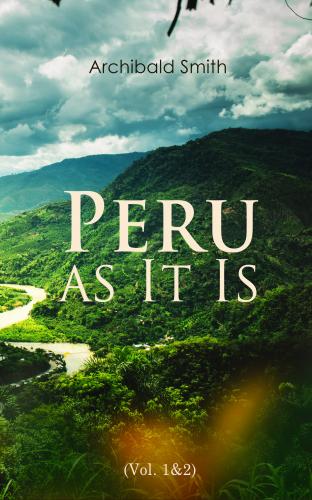Peru as It Is (Vol. 1&2). Archibald Smith
Archibald Smith
Peru as It Is
(Vol. 1&2)
An Account of the Social and Physical Features (Complete Edition)
e-artnow, 2020
Contact: [email protected]
EAN 4064066057770
Table of Contents
Volume 1
Table of Contents
PREFACE.
In this refined age and country, to make a graceful appearance as an author requires endowments to which the writer of the following pages has no pretension: neither would he have intruded himself on the public notice, had he not thought it a duty incumbent on every one who travels, to give his own country the benefit of his observation and experience. He will venture to assert, that he has had ample means of making himself acquainted with his subject, and that he has treated it with candour and impartiality.
For upwards of ten years he lived in Peru: sometimes residing among miners; at other times associating with agriculturists; and professionally brought into contact with persons of all classes and ranks in society, from the palace to the humblest hut.
In the interior of Peru, but more especially in Lima, the writer has met with great courtesy and kindness in private life, and been distinguished by very flattering marks of public favour. He therefore, it may be well believed, has not “set down aught in malice;” and he trusts that in the following pages there will not be found any thing injurious to the Peruvian people, or at variance with that lasting gratitude and honest pride with which he remembers and acknowledges their hospitality.
With respect to the manner of executing his task, he feels that he requires the indulgence of his reader; but, with regard to the matter, he persuades himself that, however unskilfully treated it may be, and however deficient in that exquisite minuteness of detail which delights the curious, it will nevertheless be found to convey to the intelligent reader a fair general idea of the physical and moral condition of Peru; which, as it is all that the writer has aimed at, so to have attained it is all that he desires.
CHAPTER I.
Boundaries of the Peruvian Republic.—General appearance and climate of the coast.—Seasons divided into Wet and Dry.—Vegetation.—Lunar influence.—Enervating effects of the climate of Lima.
Modern Peru is bounded on the north by the Republic of the Equator; on the south by the Republic of Bolivia; on the east by the Portuguese territories, or Brazil; and on the west by the Pacific Ocean. The coast of the Republic of Peru extends along the shores of the Pacific from the river Loa, which is the southern boundary that divides it from Bolivia, to the river Tumbez, which divides it on the north from Guayaquil, or the Republic of the Equator. All this extent of coast, from 3° 30´ to 21° 30´ south latitude, is naturally a desert, intersected by several rivers, of greater or less magnitude, that descend along narrow mountain-glens of the Andes to the Pacific Ocean.
Many of these rivers are dried up for several months in the year; while others, of larger size, carry a perennial stream, swelling during the rainy season in the inland country, and are never seen to shrink so much in time of drought in the elevated regions from whence they spring, as not to supply the means of irrigating and beautifying the maritime vales through which they flow as they approach the ocean.
It is remarkable that, while along the coast of Peru the eye wearies in looking at sandy plains and hills, we no sooner pass the river Tumbez than the face of nature changes: in the former range all looks arid and scorched; in the latter country all is verdant and sappy. The coast of the Equatorial Republic presents to the eye well-wooded plains; while on the coast and in the valleys of the western side of the Peruvian territory, trees, when not reared by man, are only to be met growing in favoured places in the vicinity of springs and rivers. Piura, the most northern province of Peru along the shores of the Pacific, is celebrated for its remarkably dry atmosphere; but in a rainy year, which seldom happens in this province, the pastures that suddenly spring up are surpassingly luxuriant—the very sand-fields, “arenales,” after one or two days’ rain, unfold an exuberance of life and vegetation.
The temperature of the low valleys on the coast of Peru may be said in general not to exceed 82° of Fahrenheit in summer, nor to descend much under 60° in winter.[1] Where, however, high hills closely overhang the sandy plains or dry “pampas,” it is difficult to say to what degree the thermometer may fall during night, when the rush of cold air from the upper regions is in proportion to the degree of radiation from the plains, and the force with which the sun’s rays during the day had struck on the scorched ground. So intensely on such occasions does the traveller feel the transition, that, when benighted on desert places, he is sometimes compelled by the keenness of the cold to dismount, and bury himself up to the neck in the warm sand, until a returning sun again befriend him on the morrow, and encourage him to pursue his trackless way.
In Lima, the capital of Peru, neither the extremes of heat nor of cold are ever experienced;[2] an advantage which it partly owes to its very splendid back-ground of mountains, rising one above another to the skies.
In winter, the thermometer of Fahrenheit never, in the centre of the town, falls under 60° in the shade; and, during summer, we have never seen it rise above 82°—its usual station being about 80° in well-aired apartments. The ordinary difference between the fall of the night and day thermometer is only from three to four degrees when the thermometer is placed inside
